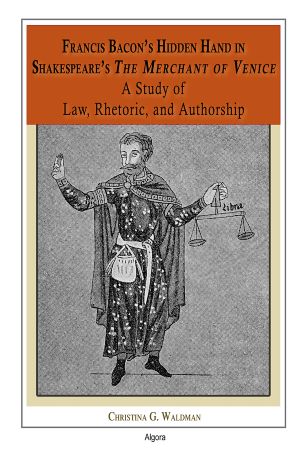by Christina G. Waldman
May 9, 2019 (updated August 21, 2019, January 20, 2020)
What do bees have to do with Bacon? The cover illustration my publishers so aptly chose for Francis Bacon’s Hidden Hand is from an illuminated manuscript, in Latin, from the 12th century, the Hortus Deliciarum (The Garden of Delights).
The book is authored by Herrad, Abbess of the convent at Hohenberg (Mont Sainte-Odile). As Fiona Griffiths explains, Herrad “authored” this illustrated work, in the legitimate sense of creatively designing, compiling, selecting and arranging/excerpting its Latin texts. The book is a compendium of the learning of the day, the most current theological treatises. Her mission was to provide the nuns of her convent with an education on a par with that being received by men in religious orders. In the Hortus, she included her own verses (See “More…On the Cover Photo.” https://www.algora.com/545/book/details.html. https://www.amazon.com/Francis-Bacons-Hidden-Shakespeares-Merchant/dp/1628943300; Fiona J. Griffiths, The Garden of Delights (Philadelphia: The University of Pennsylvania Press, 2006)). Herrad wrote that she went about like a little bee gathering “nectar” from the flowers (her various sources) and transforming it, through the creative process, into “honey” (Griffiths, 91-107).
Francis Bacon, too, used the bee metaphor (See Daniel R. Coquillette, Francis Bacon (Stanford: Stanford University Press, 1992), pp. 96-7, 106, 238-9, 283). It had a long history of being used in the transformative, spiritual, creative sense in which Herrad has used it (Griffiths, 100-103). It seems Bacon would have known that, for he read deeply in the classics, including philosophical and theological texts.
Even today, it is not uncommon for large-scale literary projects such as reference sets to have one author overseeing a number of editors and contributors.
So why is this merchant my favorite marchand, which is “merchant” in French? Because, besides being on the cover of my book, and being so darn cute, he looks a lot like a favorite person of mine, a coincidence I consider “out of this world”; hence, a pun on the old TV show, “My Favorite Martian,” in case anyone didn’t get it (I got the idea of making puns in French from Francis Bacon).

This is fascinating stuff, Lawrence! Thank you so much for sharing this excerpt from Mather Walker’s essay (which I have just finished reading). There always seems to be more to learn about the underlying meanings in the Shakespeare plays and Francis Bacon’s role in that. Before reading this essay, I would never have imagined that “A Thousand and One Nights” had any relation to “The Taming of the Shrew,” but I see it now. Nor should the twelfth century associations surprise me, since I had seen them in “The Merchant of Venice.” This essay has helped me to understand the Shakespeare plays better.
The name of this brotherhood (Sarmoung or Sarman) means Bee.
http://www.sirbacon.org/mshrew.htm (On this page which the above text is excerpted from an essay by Mather Walker, there is an image of a Candle and a Bee)
These are the people who collect the precious ‘honey’ of traditional wisdom and preserve it for future generations. Moreover, the word bee has another significance for our present study. Anyone who has ever approached a beehive knows the population of bees becomes greater the closer they approach to the hive. The population of the Sufis increases with the approach to this region in central Asia where the Brotherhood is located.
In the Sufi writers of Mystic Islam, the rose, symbol of beauty, of the generative force in universal nature, of the burning love for the divine, became the Mystic Rose which inspired the deathless longing in the heart of the mystic drawing him through all the forms of earth back toward his celestial origin. Here arose the oft repeated tale of the Nightingale (the mystic longing in the human heart) and his passionate love for the Rose (love and transcendental magnetic beauty, existing as an all powerful attractive center in the heart of deity.)
On the title page of Robert Fludd’s Summum Bonum (The Highest Good), subtitled “True Magic, Cabala, Alchemy, of the True Brothers of the Rose Cross, is a curious emblem. In the center of the emblem is a picture of a huge rose with a bee in the air beside it. To the left of the rose is a spider’s web, and to the right a bee hive. Over the rose in large letters is the legend “DAT ROSA MEL APIBUS”, i.e. “The Rose Gives The Bees Honey.” Robert Fludd was either a mask for Francis Bacon, or else they were very close. Francis Bacon was closely associated with the inception of the Rosicrucian Fraternity.
Idries Shah says there is a connection between the Sufi “Path of The Rose”, and the Rosicrucian Fraternity. In the Fama Fraternity of the order of the Rosicrucians we are told that the founder of the Order became acquainted with the Wise Men of Damcar in Arabia. These “Wise Men of Damcar” could only have been the Sufis.